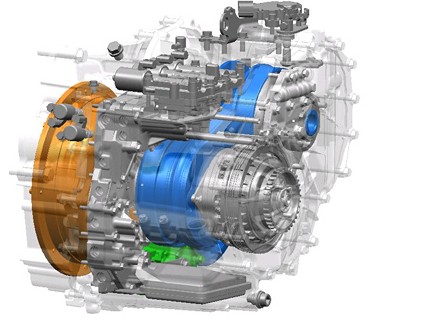In the old days, choosing a transmission was pretty simple.
With only manual and automatic options, choosing was simply a matter of deciding whether you wanted to stir your own gears, or slush along with zero effort, with the torque-converter option.
Now, alongside the manual option, you can choose cars with all manner of automatic transmissions, from the traditional torque-converter to high-tech dual-clutch units. But which is best for the green-minded driver? We've taken a look at the pros and cons of each.
Manual transmission
Manual gearboxes are actually enjoying a small resurgence in popularity, thanks to consumers wishing to save a little money on purchase price. Luckily, those consumers are discovering that manuals are far easier to drive than they used to be, with light actions, little effort needed on the clutch, and more ratios allowing for better acceleration and better low-revs cruising.
That low-revs cruising means they tend to be pretty economical, particularly in highway driving where some autos hunt around the rev range a little more. And the skilled driver can really make the most of having full gearbox control when it comes to efficiency--manuals are often the gearbox of choice for dedicated hypermilers.
It's not all good news, though. Autos have come along in such leaps and bounds that many are now more economical, and of course even the best manual isn't as easy to use as an automatic. If you're buying used, there's no guarantee that an oafish previous owner hasn't dramatically shortened the life of the transmission by riding the clutch or slamming through the gears, either, so maintenance may be more of an issue.
Torque-converter auto
The traditional auto transmission has plenty of benefits. It's generally pretty smooth, for one--not for no reason are these known as "slushboxes". The latest autos aren't just smooth, but many now offer better gas mileage than their manual counterparts, particularly when offered with more gears--seven, eight and even nine-speed gearboxes are becoming more common.

Mazda SkyActiv-Drive next-generation 6-sp automatic
Single-clutch automated manual (or "semi-automatic")
In the past these transmissions were often operated manually with a regular shift lever, but no clutch pedal. More recently, cars like the Smart ForTwo still operate in a similar way, but use an automatic-style lever or steering wheel paddles to change gears.
Theoretically, it has the same benefits as dual-clutch transmissions, but is more mechanically simple. That means economy no worse than a manual, but the ease of driving of an auto.
In practice, they can be jerky to use, with long pauses between gearshifts while electronics and hydraulics operate the clutch and gear selectors. Smoother dual-clutch units have made single-clutch versions nearly obsolete for passenger vehicles, at least in the U.S.
porsche pdk main630 01
Dual-clutch transmission (DCT)
First developed by Audi, dual-clutch automatics are now used by virtually every carmaker. One clutch operates the odd gearsets, the other the even gears. When the car or driver selects another gear, clutch engagement is switched instantly from one to the other. Drive is maintained, so it's quicker and smoother than a single-clutch unit.
Because drive is never interrupted, they can be almost as economical--sometimes more so--than a traditional manual or automatic. Less energy is wasted in moving from one gear to another, and as cars with DCTs often come with gearshift paddles, the eco-minded driver can select their own gears to improve economy.
DCTs are expensive though--picking the DSG option on a Volkswagen Jetta TDI adds $1,100 to the price, and gas mileage is identical--so you'd have to be choosing DSG for a reason other than saving money on gas.
Continuously-variable transmission (CVT)
As the name suggests, a CVT constantly varies gear ratios. This means the transmission can allow the engine to run at its most efficient speed regardless of the situation--high revs for power, low revs for economy, independent of road speed.
There's never any step in the power and torque being delivered, making these transmissions very smooth most of the time. At the same time, many drivers dislike the way a CVT lets engine revs rise and fall irrespective of road speed, and some carmakers even build in transmission modes with artificial steps to make them more appealing.
In terms of economy, they're potentially better than any of the others, at least in low load situations where engine revs never climb too much. A Nissan Versa 1.6-liter with CVT beats a five-speed manual equivalent by 3 mpg in combined EPA testing, at 33 mpg to 30 mpg.
Honda CVT transmission
Some hybrids, particularly those from Toyota and Ford, use an "electronic CVT", that uses planetary gearsets instead of belts, to combine power between a gasoline engine and electric motor. These are even more mechanically simple, smoother, and thanks to the electric running, even more economical.
Which is best for economy?
It depends. Ultimately, the car you choose has much more bearing on the amount of gas you use than the transmission you equip it with.
Like for like, you'll usually find a manual to be more efficient than an automatic, similar to a single- or dual-clutch automatic, but not as efficient as a CVT. But some carmakers do offer torque-converter autos that beat their manual equivalent, and DCTs can also use less gas.
The best news is that you have more choice than ever, and that the efficiency of any transmission is improving all the time--but with a manual gearbox, the best way to improve economy is by starting with the "nut behind the wheel"--i.e, work on your own technique!
+++++++++++













